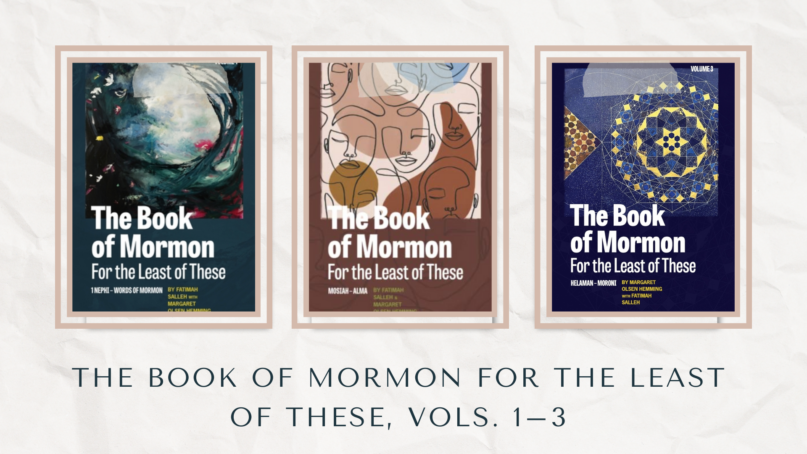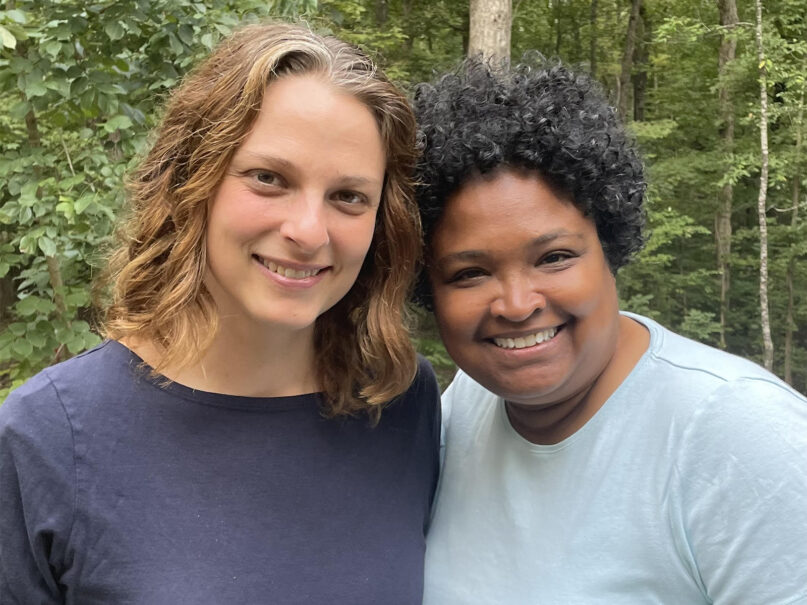(RNS) — North Carolina may seem an unlikely powerhouse for cutting-edge Book of Mormon Studies, but all three of the authors of the two new Book of Mormon resources I’m highlighting hail from the state.
Last week I ran an interview with Grant Hardy, whose “Oxford Annotated Book of Mormon” is now available. Today, I talk to Fatimah Salleh and Margaret Olsen Hemming, co-authors of the three-volume series “The Book of Mormon for the Least of These.” The third volume, which takes on Helaman through Moroni, has recently been released.
Fatimah — formally, the Rev. Dr. Salleh — is “a pastor to pastors,” working with chaplains, clergy and activists to care for their spiritual well-being. Margaret is an MTS student at Duke Divinity School and has just been named the new co-editor for “Dialogue: A Journal of Mormon Thought.”
The two met at a feminist retreat and began getting together for lunch, with discussion often turning to the Book of Mormon. Fatimah, a former Institute teacher at UNC, had been working through the text for many years, while Margaret struggled with it — particularly how it deals with race and gender. Margaret, who is white, says she has learned a great deal from Fatimah, who is African American, Puerto Rican and Malaysian, and has thought carefully about racism in the Book of Mormon. The three “For the Least of These” commentaries represent some of the fruits of their friendship and their collective wrestling with the text. This interview has been edited for length and clarity. — JKR
Margaret, you say you had a ‘complicated relationship’ with the Book of Mormon. Why?
Hemming: I felt like it was very masculine and violent. The Old Testament is both of those things, but it also has great female characters, which the Book of Mormon didn’t have. And it seemed like the messages from Jesus were better in the New Testament than in the Book of Mormon. I didn’t know what I was supposed to like about it.
Fatimah and I had lunch one day at Elmo’s Diner and I told her how I felt about the Book of Mormon. And she said, “You’re reading it the wrong way.” She started talking about how the whole text begins with an origin story of a refugee family fleeing their homeland under threat of violence and going to a new land to find sanctuary.
Salleh: You know, Margaret has such a beautiful memory. I think she’s edited some of the harshness out! ‘Cause when she said she didn’t really take to the Book of Mormon, I may have been harsher than that.
Hemming: Yes, I think your exact words were, “You shut your mouth.” (laughs)
Fatimah started talking about women and violence and the deep relationship she has with all of the authors in the Book of Mormon. I mean, she clearly engaged with them so deeply that she had this close emotional relationship with them. That was thrilling to me.
After a couple of more lunches like that, I said, “You know, you really need to write this down. Other people need to know about this.” But she was starting a new job and she’s got her four kids and she’s busy. So I said, “OK, what can I do to help make it happen?” That’s how we started working together.
Salleh: How do we begin a partnership to share authorship of a work like this? That was one of our biggest hurdles to begin with. And then there’s the complexity and the intersection of race — Black and Brown people’s work with white people.
I remember fasting when we were going through this, trying to figure out how authorship would look ’cause it was a pretty hard beginning. When I had prayed and fasted about it, I just had this overwhelming feeling to trust Margaret and that Margaret was good. That propelled me to take a risk. The biggest risk ended up not being the partnership and authorship, but just becoming good friends with Margaret. I would say the best thing I got out of these years was Margaret.
How many years are we talking about?
Salleh: Seven years. We’re talking seven years of growth, of friendship, of COVID, of sickness, of motherhood, of race relations in America, of elections and governments. That time was us witnessing a global pandemic and what was happening at the border. Margaret and I wrote in seven of the most tumultuous years of American history in my lifetime as a woman of color. None of that should be underestimated because that backdrop is absolutely a character in this work.
Hemming: Fatimah and I talk quite a bit about the process of writing it. One of our primary arguments is that what questions you ask of the text and the answers that you get out of the text depends on the body that you’re in. For us as women, especially for Fatimah as a Black-Brown woman, we asked a different set of questions than have been asked in the past. Scholarship of the Book of Mormon has historically been by academic white men from a certain socioeconomic class. We’re hoping that other people who have not had a platform for speaking about the Book of Mormon will be given more space to share different interpretations.

The complete series.
What’s an example of a Book of Mormon story you’re looking at in a completely different way?
Salleh: Our vision and lens of women in the Book of Mormon is that they are vastly underrepresented. The women seem like these minor characters. But my gosh, the wives of Nephi and Sam, the original refugee group, were bad asses. They really were. The women were doing everything those men were doing and nursing babies, too. Yet we focus only on Nephi and his brothers, and talk about Lehi’s wife “murmuring.”
Now, come on. Of course she’s going to murmur. She’s telling him, “We’re out here in this wilderness because you had a vision. And now you want to send my boys off to some dangerous, violent task?” I don’t know how she didn’t murmur sooner than that! Certainly if you would’ve gotten my butt out there, the murmuring would’ve started quite a while before.
Hemming: Here’s something else. We spent a lot of time tracing the phrase “prosper in the land” through the text. This was something I’d always struggled with, the flirtation that the Book of Mormon does with Prosperity Gospel and how sometimes it seems to embrace the idea that if you are obedient, then God gives you this set of blessings. So we looked carefully at every time “prosper in the land” came up as a promise. It’s interesting that there seem to be about half a dozen definitions of what “prosper in the land” means in the Book of Mormon.
It really depends on who’s talking. Sometimes you have people like Jarom who says, if you are obedient, God gives you these blessings, and that is prospering in the land. And then you get to Alma the Younger, who defines it as getting to have God with you (Alma 36). So there are points where the text seems to embrace prosperity as traditional power, and then there are other points where it sees prosperity in spiritual terms.
I’d like to talk about racism in the Book of Mormon. What do you do with that? And what does the book have to teach us about racial division and what not to do?
Salleh: I think it has so much to teach us. In some ways the church has shied away from all the ways that it could teach us just how insidious racism is, and how race is a social construct. Remember, this story begins as brothers who have an abusive relationship and want to separate themselves from each other. It develops within one family, with the construct being the imagination around race, absolutely.
That’s fascinating. Just so I understand correctly, you seem to be saying the Book of Mormon exemplifies that race is a social construct because this is an intra-familial story in which they are all sharing the same DNA, but they start to perceive each other as being wholly different in the color of their skin.
Salleh: Exactly. In the Book of Mormon it’s easier to see how race is absolutely a construct. Nephi’s been looking at his brothers all his life, and now they’re suddenly gonna be darker than he is? They’re all living in the same land. We’ve got to think about that deeply and tackle how the Nephites contrived race.
We have to see how they’re choosing to talk about each other, these people who are legitimately their blood and their family. This is what they’re saying about their aunts, uncles and cousins. And yet they’re able to “other” them so deeply that it fractures the community. This is how people manipulate the idea of race to make sure there’s a deep divide. At one point, Nephi is going through all the ways the Lamanites are different, like the way they hunt for beasts. And the description is absolutely like themselves, but maligned from that lens.
Hemming: Yes. The Nephites are calling the Lamanites lazy, but the Lamanites build this society that rivals the Nephites’. So where’s the laziness?
Salleh: I think we, as a church, don’t watch how this began, and how it kept propagating itself through the prophets. And then we’re not able to name it and tackle it. If you are unable to wrestle with racism in the holy text, it leaves you without the resources and skillset you need to tackle it in the now. I would beckon us in the church to ask the good questions around race: Why did the color of skin get in here? Who did it serve?
Related content:
Juicing up your Book of Mormon reading this year (Part 1, with Grant Hardy)






